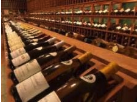Wine Cellar Coolers
Wine Cellar Coolers are installed in wine storage areas to stabilize and improve the lives of most wines. By keeping wine at a constant temperature and humidity it preserves and stabilizes the taste and color of wine allowing it to age gracefully. We can design and install a cooler system that will suit your needs We have installed many hundreds of these units.
THE SCIENCE OF WINE AGING
Oxygen, Friend or Foe?
 Oxidation is both a wine’s enemy and a wine’s friend. When oxygen reacts with alcohol, it creates acetic acid or vinegar. Too many years in the cellar and that fine Bordeaux could be composed of more vinegar than alcohol–not something typically desired to accompany a filet mignon. Oxidation also alters the colors of wine. Just like a cut apple, the wine will turn brown when it comes in contact with the air. Aged red wine is naturally brick-colored, aged white is golden-brown, but too-brown colors are undesirable. Just as a little lemon juice added to that cut apple keeps it from browning, wines with higher acidities tend to turn brown less rapidly, and so are better candidates for aging.
Oxidation is both a wine’s enemy and a wine’s friend. When oxygen reacts with alcohol, it creates acetic acid or vinegar. Too many years in the cellar and that fine Bordeaux could be composed of more vinegar than alcohol–not something typically desired to accompany a filet mignon. Oxidation also alters the colors of wine. Just like a cut apple, the wine will turn brown when it comes in contact with the air. Aged red wine is naturally brick-colored, aged white is golden-brown, but too-brown colors are undesirable. Just as a little lemon juice added to that cut apple keeps it from browning, wines with higher acidities tend to turn brown less rapidly, and so are better candidates for aging.
But exposure to oxygen isn’t all bad. Oxygen helps the fruity flavors of a young wine fade and combine with the woodsy flavors from the barrel, creating something that is more “winey” than “fruity.” Age wine more, and it will develop earthy, nutty, flavors in alongside its fruity ones. Wine is said to breathe through the cork, and it does, for the influx of oxygen through the cork’s pores helps the wine mature. (Wine purists denounce the newer synthetic corks and screw caps for just this reason.) The oxidation of tartaric acid, for example, creates some of the tertiary aromas that eventually form the kind of bouquet that wine connoisseurs will pay top dollar for. Decanting wines in a wine decanter encourages oxidation and can improve a young wine’s flavor profile.
Age Wines in a Cool, Damp Place
The wide variety of subtle reactions that take place as wine ages require very specific conditions to create an optimal product. These are a stable temperature of around 55°, a relative humidity of around 70%, and protection from direct light. Wine experts have been able to quantify what the Romans knew to be true thousands of years ago wines age best under cool conditions. An 18° increase from the 55° baseline doubles the rate of chemical reactions in wine. But if chemical reactions age the wine, why not increase the temperature and get a decade’s worth of flavor complexity in a few years?
Unfortunately, there are no such shortcuts. A temperature of 55° is the perfect environment for the chemical reactions that result in good wine. But it’s too cold to allow other, undesirable reactions that can give a wine unwanted aromas. Even a short exposure to extreme temperatures can trigger unwanted reactions and ruin the wine. Wine ages best at a temperature that is both cool and constant. Wine cellar cooling systems are designed to maintain that perfect temperature in your cellar or cabinet.
The Perfect Balance
Wine aging is a science. A single bottle of wine can contain hundreds of chemical compounds that react over time. The reactions common to each type of wine are understood, and the type of changes in the aroma that occur in them are rarely surprising. But wine aging is also an art. Each crop of grapes is different. Each bottle of wine will age a little differently from the next; the perfect time to uncork a particular grape varietal will change with the region, the year, and the specific process the grapes undergo as they are being smashed and fermented into wine.
Ultimately, it’s all about balance. A perfectly aged wine will have an optimal combination of three things: fruit flavors, fermentation flavors, and aging flavors. Whether this takes a year and a half or more than ten years depends on the bottle and the conditions it is kept in. Understanding the science behind wine aging can’t provide a magic formula that tells us when to open that particular Merlot, but it can help us understand why it needs to be kept under controlled conditions. And it can even help us guess at what flavors it might be developing as the wine slowly turns deep, reddish-brown in that dark corner of our modern, climate-controlled version of Poe’s catacombs